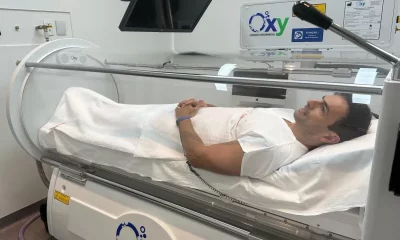
learn about new strategies in the control and treatment of migraine
Follow Us @
learn about new strategies in the control and treatment of migraine
Genotyping test – As there is still no specific medication for the disease and treatment is done with antihypertensive, antidepressant and antipsychotic medications, in addition to botulinum toxin, genetic testing is an excellent way to discover and thus prevent some migraine triggers. There are foods and drinks, or ingredients in these products, that can trigger migraine attacks. But there are also some foods that play a protective role, helping to prevent these crises depending on genetic sensitivity. Recent biotechnological advances have improved the identification of some genetic biomarkers responsible for individual sensitivity to headache and migraine. Then, it is possible to estimate the risk, adopt preventive measures and, when necessary, mitigate the symptoms and optimize the treatment. According to nutritionist Dr. Marcella Garcez, professor and director of the Brazilian Association of Nutrology (ABRAN), some of the strong symptoms of migraine can also be alleviated with a balanced diet, especially with the inclusion of Brazil nuts, tuna, cinnamon, dark green vegetables and chickpeas. beak. “Foods rich in selenium and magnesium are important to reduce stress, while antihistamines (present in cinnamon and ginger) inhibit the production of prostaglandin, responsible for the sensation of pain”, says the doctor. “Avoiding fast foods, fried foods and fatty foods, which have a more inflammatory profile and release prostaglandin, is also essential, as well as reducing the consumption of caffeine, substances that alter blood circulation and alcoholic beverages, linked to vasodilation”, explains the doctor.
Migraine Surgery – A study from the August 2020 edition of the Journal of the American Society of Plastic Surgeons, the world’s largest plastic surgery scientific journal, claims that migraine crises can end safely through surgery. The article “A Comprehensive Review of Surgical Treatment of Migraine Surgery Safety and Efficacy”, done in conjunction with the Patient Safety Committee of the American Society of Plastic Surgery, evaluated the procedure as safe and effective. “In addition, the article reinforces the importance of treatment to be incorporated by plastic surgeons and neurology societies, as a standard treatment for migraine,” says plastic surgeon Dr. Paolo Rubez, full member of the Brazilian Society of Plastic Surgery and member of the Migraine Surgery Society. The doctor is one of the few in Brazil to perform the procedure. “Migraine Surgery is now performed by several groups of plastic surgeons around the world and in more than a dozen of the main American universities, such as Harvard. The positive and similar results of the publications of the different groups prove the effectiveness and reproducibility of the treatment”, says the doctor.
Migraine surgery, recently available in Brazil and scientifically supported by a series of studies, promises to be a game changer for those who suffer from the problem. The article was a comprehensive review of the relevant literature published on the topic. According to the study, recent clinical experience with migraine surgery has demonstrated the safety and efficacy of operative decompression of peripheral nerves in the face, head and neck to alleviate migraine symptoms. The surgery is minimally invasive and aims to decompress and release the branches of the trigeminal and occipital nerves involved in the pain points. “The peripheral branches of these nerves, responsible for the sensitivity of the face, neck and scalp, can suffer compression from the structures around them, such as muscles, vessels, bones and fascia. This generates the release of substances (neurotoxins) that trigger a cascade of events responsible for the inflammation of the nerves and membranes around the brain, which will cause symptoms of intense pain, nausea, vomiting and sensitivity to light and sound”, says the doctor.
Fat grafting – Several benefits of fat grafting treatments have already been published, many of which are related to pain control. For example, a March 2019 study (Therapeutic Role of Fat Injection in the Treatment of Recalcitrant Migraine Headaches), published in the Plastic and Reconstructive Surgery Journal, concluded that migraine symptoms were successfully reduced in most cases with injection of fat. The treatment was performed on patients who persisted with some pain after nerve decompression surgery. “Different molecules secreted by adipose tissue stem cells express an anti-inflammatory effect, improving nerve regeneration and, consequently, leading to successful clinical outcomes. Pain was improved in 7 out of 9 patients over the next 3 months, according to studies,” says Dr. Paolo Rubez. The surgeon points out that fat grafting, which is minimally invasive, has proven to be a safe, tolerable and effective procedure in reducing or completely eliminating persistent neuropathy. “This technique demonstrated a significant improvement in migraine symptoms, allowing for an important improvement in the quality of life of patients with fewer side effects from medications”, explains the doctor.
Lastly, Dr. Paolo Rubez emphasizes that the surgeries are performed in a hospital environment and under general anesthesia or, in some cases, local anesthesia. “The duration of the surgery, for each nerve, is about one to two hours and the patient is discharged home the same day”, he concludes.
Featured Photo: Playback
learn about new strategies in the control and treatment of migraine
Follow AFRILATEST on Google News and receive alerts for the main news about celebrities, soap operas, series, entertainment and more!
SHARE POST AND EARN REWARDS:
Join our Audience reward campaign and make money reading articles, shares, likes and comment >> Join reward Program
FIRST TIME REACTIONS:
Be the first to leave us a comment, down the comment section. click allow to follow this topic and get firsthand daily updates.
JOIN US ON OUR SOCIAL MEDIA: << FACEBOOK >> | << WHATSAPP >> | << TELEGRAM >> | << TWITTER >
#learn #strategies #control #treatment #migraine
-
News2 months ago
Harry decides to appeal after loss of police protection in the UK
-
Good News TV series2 months ago
Preta Gil is the new presenter of TVZ on Multishow
-
Good News TV series2 months ago
Justin Bieber and Hailey go to church using a powerful car
-
Good News TV series2 months ago
Fuzuê: Pascoal is sentenced to more than 70 years in prison
-
Health and Fitness2 months ago
Hyperbaric Oxygenation accelerates recovery from knee injuries, according to USP study
-
News3 months ago
Viradouro wins the Rio de Janeiro Carnival title in 2024 now news
-
Culture2 months ago
the Sub4 Turismo package that we recommend and we go (on the 42 km)
-
Health and Fitness3 months ago
See tips for getting pregnant after age 40










































